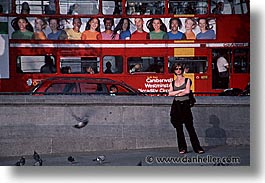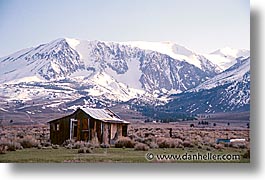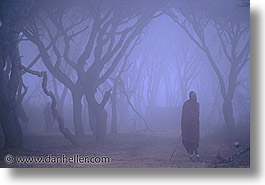|
Markers indicate locations for photos on this page.
Accuracy responsibility of Google Maps
Google Map Goes Here
If you see this text, the map is still loading (or there's an error). |
One of the main determining factors will be your propensity for starting and running your own business as a fulltime endeavor. It's not that you have to do this to sell stock on your own, but if you make anything less than a seriously concerted effort, the payback may not seem worthwhile. Yet, even if you have what it takes to run your own business, it doesn't mean you'll want to. There are also lifestyle considerations: taking pictures is one thing; running a business is another. Doing them at the same time demands a different quality of time that is often incompatible with the photographer mindset. "Context switching" from the creative mind to the business mind is not easy or enjoyable for those who already find business a struggle to begin with. For these and other reasons, it may be preferable to work with a stock photo agency. This is a company that markets and sells images on behalf of photographers in return for a percentage of the sales. In theory, this is a great win-win scenario, since the agency handles everything, leaving you to just go out and shoot as the money trickles in. In practice, it's not quite so simple. My favorite quote applies here:
If you're attracted to this idea, remember: you're not the only one to
think of it. So now there's that problem of supply and demand.
These chapters do not discusses what to do, or how to go about it,
which is an entirely different set of considerations. Nor do I
discuss pricing methods in this context. For a general discussion on
that, see Photography Pricing. The goal here is to present an unbiased analysis
of how the process and the industry works, so that you can draw your
own conclusions on whether or how much to commit to this.
I have worked with stock photo agencies in the past, but I currently do not.
I have instead chosen to represent myself, selling images directly to
buyers. (You can read more about this in Web-based Photography Business.) This does not
mean I am biased against agencies; it only means that I have found
that my skills, interests and business objectives serve me better (yield
a better return) if I represent myself. That is, I'm rather technical, so
I know how to build my own website, optimize traffic to it, market myself
effectively, negotiate prices, etc. There is a panoply of skills that people
excel in better than others; it's this mixture that determines whether (and
which) agency would serve you better than others, or than yourself.
Scrambling to maintain revenue levels, and to revive sales of images that weren't moving at all, agencies started playing with several new ideas. First, the concept of royalty-free images (termed "RF") was born. Here, CDs with several hundred photographs sold for as little as $150, and the buyer had no restrictions on use.
The next evolutionary phase for agencies came when more decided to choose the "microstock" model, which is similar to RF, but instead of selling collections of works on physical CDs, buyers could merely download them from websites. As images continued to outpace demand, prices dropped. While slim margins can still realize profits for individuals and very small niche agencies, larger agencies are expanding their services to include specialized photography services, where customized images are produced on demand for customers: sports, news coverage, celecbrities, and other kinds of event-related content is still difficult for the consumer to compete with. Similarly, niche industries like fashion and products still command higher prices, and larger agencies that can serve these images are at least surviving. Agencies once again have a big edge on the individual photographer in that their size and scope avails them of equipment and space that most photographers only dream of.
So, what does all this mean about the prospects of the individual
photographer (professional or amateur) selling images? The answer is
the same whether you're with an agency or not: it's a hard, competitive,
and often conflicting market. Determining whether to work with an agency
requires examining different analysis than simply the nature of the
stock industry itself.
My usual response is,
Search fatigue is the result of "too many choices," especially when few of them satisfy the need. But the cause of this is not just because you (or an agency) has too many pictures to choose from—it's an industry-wide problem, which is because it's a world-wide phenomenon from (again) truism #1. As long as there is over-saturation, there will be a decline in the perception of value.
This illustrates that the market is often bifurcated between the high end and the low end, with a wide gap in between. Depending on the importance of an image, the perception of price can range along the spectrum between the commodity "widget", where one widget is no different than another, and the valuable name-brand photo that is critical to a company's public image. These high-end images command the higher prices, but those sales are few and far between. The low-end images are sold at fire sale prices, but they often come in waves, where money is made on sheer volume. This is the point at which buyers segment into two categories: the commodity buyer, where price is the driving consideration; or the sophisticated buyer, who finds the image itself to be the more critical element. I don't mean to imply a discrete separation of these groups of buyers. In fact, it's more of a spectrum that graduates along the endpoints, not a strict division between the two. Most buyers are somewhere in the middle, although they do tend to bunch up towards one end or the other, graphed like a two-humped camel. Stock photography is a business that, for the most part, requires volume, because the frequency and price of higher-end sales will often pale in comparison to the volume of lower-priced sales in a photographer's income statement. Buyers get used to this, and form the impression that different uses demand different prices, and once the use is determined (hence, their perception of the "value" of getting the right image), they don't see that images themselves command different prices. Given the same end use, they believe that any photo should cost the same as any other. This perception is further supported by the fact that most photo sellers (agencies and photographers alike) usually have price points that vary among uses as well, where price points apply to all photos in the catalog.
The net result; royalty-free pricing has not affected the price points
for rights-protected images, and since different buyers exist for each
discrete market, an agency (or a photographer) could find a viable
business model doing either or both without compromising the other.
For example, a stock agency that deals strictly with weather-related images may be a primary source for government agencies, travel companies, or news organizations that need to license images to accompany a news story, or to promote or vacation idea. Consider the huge number of images on the internet that feature "lightning," but it takes a lot of time for a buyer to sift through all those sources to find a set of viable options quickly. It's more time-efficient to go to a single source for this type of material, assuming that the source has a good track record for providing suitable images over time. Experience shows that buyers are willing to pay a premium for that convenience.
To summarize the buyer's perspective, the important elements are:
The last point was not discussed in this section because it is addressed
more thoroughly later. That notwithstanding, the better you or your agency
is at servicing these needs, the more successful you'll be at being one
of those suppliers.
Whatever your strategy, you will confront with the single biggest hurdle that faces every single photographer and stock agency today, a point that I beat into the ground every chance I get: the supply of photos exceeds demand. You may, in fact, satisfy all the needs and checklist items that satisfy the buyer. The question then becomes, is the market big enough to fuel a business? Consider the photographer that has tons of lightning photos. Let's assume he's also got stock photos of all sorts of weather conditions and other related imagery. Now consider all those buyers that need them. Sound like a viable business to you? If you think you know, I assure you, you're wrong. One cannot predict the size of any given market segment, unless one has been in the market in some capacity already. If you're "thinking" of getting into this business, but haven't already been in the business to know the answer to that pivotal question about whether your own market size is viable to support you, it's probably going to be a mistake.
But, all is not lost. For the serious professional photographer,
the decision whether to get into the stock business, let alone to work
with an agency, hangs on the answer to this question: is your stock
base is broad enough to appeal to a large enough audience, while
assuring that your quality isn't compromised? As often used in scientific
lingo, you have to exceed a "critical mass" of stock images in quantity
and variety to achieve a stable, reliable, and self-sustaining business
model.
It's one thing to shoot a lot, but maintaining a photo database is time-consuming, not just to ramp up, but to maintain. This is a doable process, and those with experience with computers have a considerable advantage over those who don't. There are programs that assist with this, and it's beyond the scope of this chapter to review them. You'll need to do your homework on what's "currently" available, and gauge your own degree of competence in this area.
This task requires skills beyond photography. See Marketing your Photography Business for a detailed discussion. Your ability to market well is critical to making it in the stock photo business on your own. Again, it's doable, and more people can do it than who think they can, but it still isn't for everyone.
This is difficult at best, confrontational at worst. But, having a top-down view on business strategies and working within the scope of your long-term objectives makes this task more palatable.
If you're still working with traditional film, you're going to find a lot of overhead that your competition doesn't have. The stock industry has moved towards digital faster than any other technological change in the photo business. Whether film or digital, you still have to keep track of your clients, your photos, and who has what and what their issues are. Doing this with physical film requires infrastructure in itself, not to mention the financial overhead of materials and postage, but you may also need to pay an assistant. Worst of all is getting clients to return images they have. With digital, that's not so much a problem, but it's equally frustrating just keeping tabs on who is considering what.
This can get really ugly at worst, and just plain time-consuming at best. Again, how you weather this has everything to do with your propensity for organizing yourself in a business environment. It's beyond the scope of this article to address any of these points in depth, but one doesn't have to read further to know these tasks are a huge investment of time, money, and headaches. It's not that going at it on your own isn't worthwhile, but it may not be for everyone.
If I've talked you out of trying to sell stock photography on your own,
and you're now eager to work with a stock photo agency, don't get too
excited. There are many downsides to this prospect as well, the most
important of which is the financial bottom line: the supply/demand
imbalance has forced prices downward, and the trickle-down effect through
the supply chain has a ripple effect. The stock agency gets the first
chunk of money, leaving the rest to the photographer, which, as you can
guess, is pretty low at this point. Worse, the photographer's income
is further eroded by the ratio of photographers to agencies: the more
photographers there are, the less the agency is compelled to pay them.
In order for photographers to make money, they must be as aggressive
with price as they can (meaning, "willing to take less") or the agency
will simply work with others. (Ok, it's not quite that simple, but
we'll get into that later.)
Of course, many agencies may deny that favoritism is given to those with different royalty rates, and/or that royalties are fixed among photographers. While that probably is true for the majority of them, exceptions are always made for "exceptional" people/conditions. After all, business is business. We'll return to this issue, and many like it, in Working with Stock Photography Agencies.
The hypothetical magazine example above doesn't even begin to touch upon
all the problems in working with agencies. But, to quickly jump to it,
here are the highlights of typical problems people most often complain
about when working with stock photo agencies:
stack to matter.
that no one knows who owns which images, and some photos are actually
sold without royalties paid to any photographer.
This begs new questions: if the total number of photographers is
growing, why is a smaller percentage of them working with agencies?
Why do photographers work with agencies at all? We already examined the
pitfalls of going at it alone, so is it a question of choosing the lesser
of two evils? What about those who do not complain about agencies?
They must be doing something right, or at least, the agency they chose
is doing something for them that keeps them loyal. To understand that,
let's look at the agencies perspective.
Each of these items could be a book by itself, and I can't possibly flesh out the details of each suitably. For example, the first point about "managing physical images," requires tasks like scanning images, building and maintaining electronic databases, keywording and describing images, building and designing the hardware and software necessary to do all these tasks, synchronizing all this data with the web server, keeping slides in the right boxes, tagging and tracking where the original slides are, where they go next, getting them back from where they were, and (deep breath) collecting them all back up and sending them back to the photographer after he's notified you that he's terminated his relationship with you because you haven't been able to sell any of his images.
You probably got the idea by now. There's a lot to running an agency,
which is why most stock photo agencies go under at the same rate that
restaurants do (and often for the same reasons). A great cook thinks that
he wants to open a restaurant, only to find out that he's under-capitalized,
and has no business experience. Well, the same often happens with stock
agencies. But, of course, not all restaurants are a failure, just as not
all stock agencies are. The point is, "it's hard," and keeping the photographer
happy is only a small portion of the difficult tasks at hand.
To see how these relationships can be rather tricky to satisfy
simultaneously, let's review that magazine example, worth $175 (of which
$30-40 goes to the photographer). To put things into perspective, this
is not a huge revenue-generator for the agency. That image could have
been provided by any photographer in the agency, so it's arbitrary whose
is used. Or is it? Was the decision purely arbitrary? Given the low
dollar amount, the agency didn't choose the photographer solely because
of a more advantageous royalty structure. There must be more to it.
To see how seemingly unrelated events fit together to form a complete
picture, let's break away for a moment and consider an entirely different
scenario. We'll get back to this example afterwards.
So now let's return to that small $175 stock image sale: sure, the
client may have been shown an image from another photographer in the
agency, but if the agency wants to keep its top photographers happy,
it's more likely to promote their portfolios over the other, lower-rung
photographers. In the big picture, the agency must first look out
for the interests of its goose that lays golden eggs. How can we
measure whether this works? By looking at the income levels of the
photographers in any given agency and running a graphical distribution
chart and examining the results. According to reports from Getty Images,
as an example, 80 percent of its payouts go to 20 percent of its
photographers. That mysteriously consistent 80/20 rule applies again,
which we'll return to again a little later.
If you're at all like most photographers, you will, at some point in your career, proclaim the very true and valid statement (usually in a high-pitched, very annoying voice):
Yet, if your images were chosen, some other photographer would make
the same valid complaint against you. In short, "quality" is subjective.
When it comes to dealing with large quantities of images, and making
business choices on what to "push," quality, per se, isn't as responsible
for a sale as "the relationship" is. This goes between the photographer
and the agency as much as it does between agency and the buyer.
Again, not all agencies work the same; this discussion is only to
illustrate an abstraction by which an agency operates. There are
some photographers who've witnessed this type of thing, even though
the circumstances and conditions may have been different.
Remember, it's difficult and costly to run a stock photo agency,
and unless care is taken to assure profitability, the agency may not
survive. Again, most don't. This isn't necessarily because people
didn't apply some of these rules—in fact, it could be because they
did apply them, but did so poorly.
Based on the above discussion, the question becomes, what does it take to
be one of the chosen few star photographers in the agency, whose works are
viewed more often than everyone else's? Put succinctly, the top-tier
photographers usually are one or more of the following:
have already gained a personal reputation in the industry.
with a huge collection of immediately marketable images ready to go.
For completeness, I should point out that yes, talent, vision, style
and a demonstrated success are important, but to be a top-tier
photographer, you need all that, plus reliability. If the agency
can't depend on you and confidently assume that you're going to come
through and perform consistently, time and time again, you're a risk.
(You're only as good as your last project.)
There's certainly nothing wrong with that perspective; in fact, you're not alone. Most people who go to agencies today have this very mindset. That's not to say that all photographers at agencies think this way. It's just that a large percentage of them are more casual about their income expectations. Ok, if that's the case, what kind of income expectations should you have?
To answer that, we can now put together various topics we've discussed to
understand the full picture of how photo agencies work. As we've seen,
some business yields small revenue, other business is lucrative. If, at
the end of the year, one were to itemize each "deal" on a pie-chart graph,
a very familiar pattern will emerge, one that seems to be intrinsic to
most commodity-based businesses: the 80/20 rule. In summary,
In the stock photo business, you can state the concept this way: "a small percentage of clients are paying high prices to have access to a small percentage of photographers' images." It's a self-perpetuating formula: for the agency to make the big bucks, it has to keep its star photographers happy, thereby turning more business their way, which reinforces the 80/20 breakdown. This is why the pattern is so common in commodity-based businesses.
The 80/20 split wasn't "soft"—that is, open to interpretation—so it firmly establishes a huge disparity between the top tier photographers and those on the bottom. So, when you said that you weren't that serious about photography, and you wanted to let whatever money the agency made trickle in, that's exactly what you're going to get: a trickle. This now prompts the question, "if the revenue is so low for 80 percent of the photographers, why does the agency represent these masses of photographers at all?" One would think that the overhead of dealing with so many people would justify dumping the majority of the non-performers, and put more investment in the sales and promotion of the top performers. Turns out, there are several reasons for keeping the under-performing masses:
Many old-school photographers today complain about this, claiming that the new-school photographers are being taken advantage of. But, the cost/benefit analysis usually shows that the flat salary paid to assignment photographers often compares nicely against the potential for royalties in the short term. Granted, the longer-term prospects are less advantageous, but the job is not designed to be a long-term career; an assignment photographer should only do so long enough to get experience in the industry and later move on. (Unless, of course, he can demand a higher pay salary for his work, which is not uncommon.) All this relates to career strategies, which is discussed in Photography and Business Sense.
Click to recommend this page: |
|























